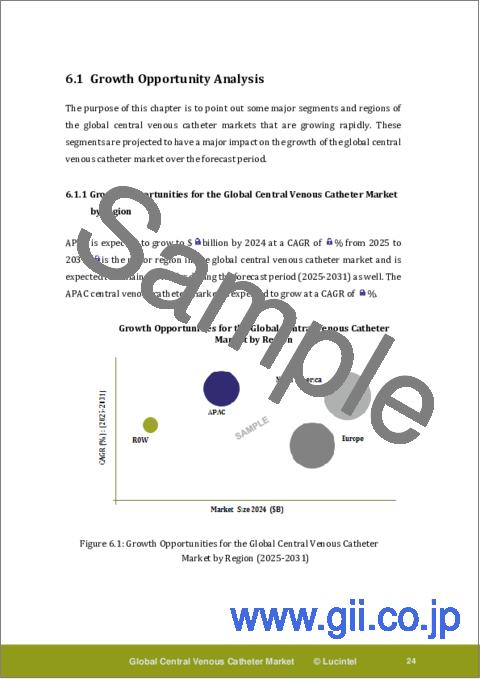|
|
市場調査レポート
商品コード
1665004
中心静脈カテーテル市場レポート:動向、予測、競合分析 (2031年まで)Central Venous Catheter Market Report: Trends, Forecast and Competitive Analysis to 2031 |
||||||
カスタマイズ可能
適宜更新あり
|
|||||||
| 中心静脈カテーテル市場レポート:動向、予測、競合分析 (2031年まで) |
|
出版日: 2025年02月27日
発行: Lucintel
ページ情報: 英文 150 Pages
納期: 3営業日
|
全表示
- 概要
- 目次
世界の中心静脈カテーテル市場の将来は、病院とがん治療センター市場に機会がありそうです。世界の中心静脈カテーテル市場は、2025年から2031年までのCAGRが6.5%で、2031年までに推定47億米ドルに達すると予想されています。この市場の主な促進要因は、腎臓病の有病率の増加、透析患者の増加、抗菌カテーテルの需要拡大です。
- Lucintelの予測では、製品種類別では、非トンネル型カテーテル分野が予測期間中も引き続き拡大します。
- 最終用途別では、予測期間中、病院がより大きなセグメントであり続けると思われます。
- 地域別では、北米が予測期間中最大の地域です。
中心静脈カテーテル市場の戦略的成長機会
中心静脈カテーテル市場では、さまざまなイノベーションに対する需要が増加しており、さまざまな医療用途にわたって多くの戦略的機会をもたらす成長分野となっています。これらの技術革新は現在の市場には欠けており、追求されれば対象市場へのアクセスを大幅に改善し、患者の罹患率と死亡率を高めることになります。
- 腫瘍治療:長期の化学療法でCVCを必要とする患者数が増加しているため、腫瘍治療におけるCVCの需要が増加しています。この分野では、頻繁な薬剤供給や採血のために設計されたCVCが戦略的な成長機会となります。
- 透析用途:糖尿病や高血圧のために慢性腎臓病が増加しており、透析療法におけるCVCの使用が増加しています。このことは、高流量透析プロセスに適したカテーテルを製造する業界リーダーにとって重要な成長機会となります。
- 小児医療:特殊で小型化されたCVCの将来的な成長は有望であるため、この分野に焦点が当てられています。この種のカテーテルは、小児に侵襲性の低い手技で長期的にバスキュラーアクセスを提供するという課題に対処するものであり、小児用バスキュラーアクセス市場の拡大につながります。
- 集中治療室(ICU):集中治療室(ICU)では、重症患者管理のためにCVCの役割が増大しています。感染リスクを低減しながら長期的な静脈アクセスを提供するカテーテルには市場成長の可能性があります。
- 在宅医療ソリューション:施設ベースの医療サービスから在宅医療サービスへと重点がシフトしています。そのため、特に慢性疾患や長期治療の管理用に設計された在宅用CVCは、メーカーに市場機会を提供しています。
腫瘍学、透析、小児科、重症治療室(ICU)、在宅医療における中核的な拡大機会は、技術革新が特定の患者の状況や長期のケアに焦点を当て続けていることから、CVC市場を拡大しています。
中心静脈カテーテル市場促進要因・課題
中心静脈カテーテル市場は、技術、経済、規制の各要因の影響を受けています。同時に、継続的な成長とイノベーションを確保するために対処しなければならないいくつかの主要課題にも直面しています。
中心静脈カテーテル市場を牽引する要因は以下の通り:
- 長期療養に対する需要の高まり:患者の専用ケアを必要とする慢性疾患への傾向が強まっており、これがCVC市場を押し上げています。これらのカテーテルは、長期の治療を行うための重要な血管アクセス機器です。
- 技術の進歩:市場の発展は、抗菌コーティングやバイオフィルム抑制素材などの技術革新に支えられた製品開発によって大きく後押しされています。
- 慢性疾患の蔓延:がんや腎臓病などの慢性疾患の増加が、ドラッグデリバリーや透析の主要手段であるCVCの市場を後押ししています。
- 感染予防への注目の高まり:カテーテル関連合併症を減らし、挿入技術を向上させるカテーテル技術の進歩により、医療従事者はさまざまな安全設計が施されたより高度なCVCを採用するようになっています。
- 在宅医療の成長:特に慢性疾患に対する在宅医療サービスの利用が増加しているため、監視のない環境でも安全に使用できるCVCの需要が高まっています。
中心静脈カテーテル市場における課題は以下のとおり:
- 感染リスクの高さ:それにもかかわらず、長期間使用されているCVCは、感染に関連する合併症による罹患率が依然として高いです。感染予防は、すべてのメーカーにとって依然として大きな障害となっています。
- 先端技術のコスト:特に発展途上諸国では、抗菌特性を内蔵したような高度な機能を備えたCVCの受け入れと適用はコスト面で制約があります。
- 規制上のハードル:国によって規制ガイドラインは様々であり、その中にはメーカー、特に医療機器メーカーにとって困難なものもあります。医療機器規制は進化しており、メーカーは承認や認証を頻繁に更新する必要があります。
長期介護需要の増加や在宅医療の成長といった主要要因の拡大が、CVC市場の成長を後押ししています。とはいえ、これらの市場には、感染リスク、コスト、規制、市場競争をよりよくコントロールするために対処すべき課題があります。
目次
第1章 エグゼクティブサマリー
第2章 世界の中心静脈カテーテル市場:市場力学
- イントロダクション、背景、分類
- サプライチェーン
- 業界の促進要因と課題
第3章 市場動向と予測分析 (2019年~2031年)
- マクロ経済動向 (2019~2024年) と予測 (2025~2031年)
- 世界の中心静脈カテーテル市場の動向 (2019~2024年) と予測 (2025~2031年)
- 世界の中心静脈カテーテル市場:製品種類別
- トンネル型カテーテル
- 非トンネル型カテーテル
- 世界の中心静脈カテーテル市場:特性別
- 抗菌性カテーテル
- 非抗菌性カテーテル
- 世界の中心静脈カテーテル市場:設計別
- シングルルーメン
- ダブルルーメン
- マルチルーメン
- 世界の中心静脈カテーテル市場:最終用途別
- 病院
- がん治療センター
- その他
第4章 地域別の市場動向と予測分析 (2019年~2031年)
- 世界の中心静脈カテーテル市場:地域別
- 北米の中心静脈カテーテル市場
- 欧州の中心静脈カテーテル市場
- アジア太平洋の中心静脈カテーテル市場
- その他地域の中心静脈カテーテル市場
第5章 競合分析
- 製品ポートフォリオ分析
- 運用統合
- ポーターのファイブフォース分析
第6章 成長機会と戦略分析
- 成長機会分析
- 世界の中心静脈カテーテル市場の成長機会:製品種類別
- 世界の中心静脈カテーテル市場の成長機会:特性別
- 世界の中心静脈カテーテル市場の成長機会:設計別
- 世界の中心静脈カテーテル市場の成長機会:用途別
- 世界の中心静脈カテーテル市場の成長機会:地域別
- 世界の中心静脈カテーテル市場の新たな動向
- 戦略的分析
- 新製品の開発
- 世界の中心静脈カテーテル市場の生産能力拡大
- 世界の中心静脈カテーテル市場における企業合併・買収 (M&A)、合弁事業
- 認証とライセンシング
第7章 主要企業のプロファイル
- Rex Medical
- B. Braun
- Teleflex
- AngioDynamics
- ICU Medical
- Vygon
- Medtronic
- Merit Medical Systems
- Asahi Kasei
- Becton, Dickinson and Company
The future of the global central venous catheter market looks promising with opportunities in the hospital and cancer treatment center markets. The global central venous catheter market is expected to reach an estimated $4.7 billion by 2031 with a CAGR of 6.5% from 2025 to 2031. The major drivers for this market are the increasing prevalence of kidney diseases, the growing number of dialysis patients, and the expanding demand for antimicrobial catheters.
- Lucintel forecasts that, within the product type category, the non-tunneled catheter segment will remain a larger segment over the forecast period.
- Within the end use category, hospital will remain a larger segment over the forecast period.
- In terms of regions, North America will remain the largest region over the forecast period.
Gain valuable insights for your business decisions with our comprehensive 150+ page report.
Emerging Trends in the Central Venous Catheter Market
The central venous catheter market has been undergoing several transformations caused by new developments in materials, configuration, and safety features. These trends are transforming the market and unlocking new avenues for growth.
- Application of Antimicrobial Coating: Embedding antimicrobial coatings on CVCs has become common to minimize the risk of infections. This trend reduces the incidence of catheter-related bloodstream infections (CRBSIs), which pose a significant risk to patients.
- Ultrasound-Guided Insertion: This increase is due to the introduction of the ultrasound-guided approach in CVC insertion, which enhances precise placement and decreases complications. This trend improves the safety of patients as well as their clinical outcomes.
- Catheters with Biofilm-Resistant Materials: Catheters made with biofilm-resistant materials and antibacterial coatings are being developed to prevent fluids from getting stuck within the catheters. This innovation assists in the prevention of infections and extends the life of the catheters.
- Minimally Invasive Designs: There is a growing inclination towards less traumatic CVCs when inserting and removing, which are classified as minimally invasive. This is particularly helpful in the case of children and elderly patients where long-term care is needed.
- Single Lumen Catheters for Targeted Applications: With advancements in medical practice, single-lumen catheters are being strategically designed for specific medical applications such as cancer therapies and kidney dialysis. This trend accommodates the increased need for long-term vascular access for targeted therapy.
Those changes-the use of antimicrobial coatings, ultrasound for insertion facilitation, materials resistant to biofilms, minimally invasive designs, and single-lumen catheters-will change the CVC market trend by maximizing safety and care efficiency.
Recent Developments in the Central Venous Catheter Market
The recent developments in the central venous catheter market are focused on both the risks that patients are exposed to and the infection rates associated with the catheter, while also making the catheters more functional. These innovations reflect the rising demand for vascular access that is innovative for long-term use.
- Antimicrobial-Coated Catheters: There has been a new development of CVCs in the form of antimicrobial-coated CVCs, which help to prevent infection. Moreover, this coating is very effective in preventing CRBSIs, thereby minimizing the complication risk related to long-term catheter usage.
- Advanced Catheter Stabilization Devices: Catheter stabilization devices that limit the movement of the catheter and prevent its dislodgment have been widely embraced. These reductions in catheter-related complications are expected to result in a positive impact on patients.
- Biofilm-Resistant Catheters: Another major advancement meant to prevent bacterial infiltration and infection in CVCs is the inclusion of biofilm-resistant materials in the devices. These materials enable longer catheter durations, thereby reducing the frequency of catheter changes.
- Ultrasound-Guided Catheters: The wider usage of ultrasound-guided catheters decreases the rates of placement errors and related complications. Such advancements are especially advantageous for patients with difficult-to-find veins.
- Miniaturized Catheters for Pediatrics: The new miniaturized CVCs used for pediatric care focus on reducing the size of the catheter, allowing for longer use in children with better biocompatibility.
These new approaches antimicrobial surface coatings, stabilization devices, biofilm-resistant materials, ultrasound-assisted catheterization, and innovations targeted at pediatric patients are increasing overall safety, decreasing complications, and improving the efficiency of central venous access and catheter use.
Strategic Growth Opportunities for Central Venous Catheter Market
There is an increase in the demand for various innovations in the central venous catheter market, making it a growing field with many strategic opportunities across different healthcare applications. These innovations are lacking in the current market, and if pursued, they will significantly improve access to the target market and enhance patient morbidity and mortality.
- Oncology Treatment: There is an increasing demand for CVCs in oncology due to the rising number of patients requiring CVCs for long-term chemotherapy. This segment of the industry presents a strategic growth opportunity with CVCs engineered for frequent drug supply and blood sampling.
- Dialysis Applications: Chronic kidney disease is on the rise due to diabetes and hypertension, increasing the use of CVCs in dialysis therapy. This presents an important growth opportunity for industry leaders manufacturing catheters suitable for high-flow dialysis processes.
- Pediatric Care: The future growth for specialized and miniaturized CVCs is promising, hence the focus on this area. These types of catheters address the challenge of providing vascular access in children through less invasive procedures over the long term, thus expanding the pediatric vascular access market.
- Intensive Care Units (ICUs): The role of CVCs in ICUs for critical care management is increasing. There is potential for market growth in catheters that offer long-term venous access while reducing the risk of infection.
- Home Healthcare Solutions: There has been a shift in emphasis from institution-based healthcare services to home-based healthcare services. As such, CVCs designed for home use, particularly for managing chronic diseases and long-term treatments, provide a market opportunity for manufacturers.
Core expansion opportunities in oncology, dialysis, pediatrics, critical care units (ICUs), and home healthcare are expanding the CVC market as innovation continues to focus on specific patient situations and prolonged care.
Central Venous Catheter Market Driver and Challenges
The central venous catheter market is influenced by bundled technological, economic, and regulatory factors. At the same time, the industry faces several primary challenges that must be addressed to ensure ongoing growth and innovation.
The factors driving the central venous catheter market include:
- Rising Demand for Long-Term Care: There has been a growing trend towards chronic conditions that require dedicated care for patients, which has pushed the CVC market. These catheters are important vascular access devices for prolonged therapies.
- Technological Advancements: Market expansion has been significantly driven by product development, aided by innovations such as antimicrobial coatings and biofilm-inhibiting materials.
- Growing Prevalence of Chronic Diseases: The increasing number of chronic conditions, including cancer and kidney disease, boosts the market for CVCs, which are primary means of drug delivery and dialysis.
- Increased Focus on Infection Prevention: Advancements in catheter technology that reduce catheter-related complications and ensure better insertion techniques are encouraging healthcare professionals to adopt more advanced CVCs with various safety designs.
- Growth of Home Healthcare: The increase in the use of home-based healthcare services, especially for chronic diseases, is driving the demand for CVCs that can be used safely in unsupervised environments.
Challenges in the central venous catheter market are:
- High Risk of Infection: Nonetheless, CVCs that have been in use for prolonged periods are still associated with high morbidity rates due to complications related to infection. Infection prevention remains a significant obstacle for all manufacturers.
- Cost of Advanced Technologies: The acceptance and application of CVCs with advanced features, such as built-in antimicrobial properties, are cost-restrictive, particularly in developing countries.
- Regulatory Hurdles: Different countries have varying regulatory guidelines, some of which may be challenging for manufacturers, especially for medical device companies. Medical device regulations are evolving, requiring manufacturers to frequently update their approvals and certifications.
Expansion of major factors like rising demand for long-term care and the growth of home healthcare is driving CVC market growth. Nevertheless, these markets have challenges to be addressed to enable better control over infection risks, costs, regulations, and market competition.
List of Central Venous Catheter Companies
Companies in the market compete on the basis of product quality offered. Major players in this market focus on expanding their manufacturing facilities, R&D investments, infrastructural development, and leverage integration opportunities across the value chain. Through these strategies central venous catheter companies cater increasing demand, ensure competitive effectiveness, develop innovative products & technologies, reduce production costs, and expand their customer base. Some of the central venous catheter companies profiled in this report include-
- Rex Medical
- B. Braun
- Teleflex
- AngioDynamics
- ICU Medical
- Vygon
- Medtronic
- Merit Medical Systems
- Asahi Kasei
- Becton, Dickinson and Company
Central Venous Catheter by Segment
The study includes a forecast for the global central venous catheter market by product type, property, design, end use, and region.
Central Venous Catheter Market by Product Type [Analysis by Value from 2019 to 2031]:
- Tunneled Catheters
- Non-Tunneled Catheters
Central Venous Catheter Market by Property [Analysis by Value from 2019 to 2031]:
- Antimicrobial Catheters
- Non-Antimicrobial Catheters
Central Venous Catheter Market by Design [Analysis by Value from 2019 to 2031]:
- Single Lumen
- Double Lumen
- Multiple Lumen
Central Venous Catheter Market by End Use [Analysis by Value from 2019 to 2031]:
- Hospital
- Cancer Treatment Centers
- Others
Central Venous Catheter Market by Region [Analysis by Value from 2019 to 2031]:
- North America
- Europe
- Asia Pacific
- The Rest of the World
Country Wise Outlook for the Central Venous Catheter Market
Major players in the market are expanding their operations and forming strategic partnerships to strengthen their positions. The image below highlights recent developments by major central venous catheter manufacturers in key regions: the USA, China, India, Japan, and Germany.
- United States: In the U.S., the use of antimicrobial-coated CVCs is gaining popularity due to the decreasing trend of catheter-related infections. Recent innovations include improved approaches to catheter insertion and the development of ultrasound-guided catheters for better patient care.
- China: The demand for advanced healthcare infrastructure in China is fueling the growth of the Chinese CVC market. Recent developments include the incorporation of antibacterial elements into CVCs to prevent infections and the creation of low-cost but high-quality catheter options.
- Germany: The German market for central venous catheters focuses on modern technologies that can prevent infections. Examples include the integration of biofilm-preventing materials and optimization of catheter securement methods to decrease risks associated with prolonged catheterization.
- India: The increasing prevalence of long-term care needs among the population in Intensive Care Units and oncology departments in India has led to a rise in the usage of central venous catheters. Recent developments have focused on low-cost solutions that improve safety for patients, particularly those requiring long-term catheterization.
- Japan: In addition to the principles mentioned above, Japan is pursuing the miniaturization of CVCs and developing more innovative biocompatible options. The nation is also integrating minimally invasive methods and advanced technologies that enhance the accuracy and safety of catheter devices, particularly for younger and older individuals.
Features of the Global Central Venous Catheter Market
Market Size Estimates: Central venous catheter market size estimation in terms of value ($B).
Trend and Forecast Analysis: Market trends (2019 to 2024) and forecast (2025 to 2031) by various segments and regions.
Segmentation Analysis: Central venous catheter market size by various segments, such as by product type, property, design, end use, and region in terms of value ($B).
Regional Analysis: Central venous catheter market breakdown by North America, Europe, Asia Pacific, and Rest of the World.
Growth Opportunities: Analysis of growth opportunities in different product types, properties, designs, end uses, and regions for the central venous catheter market.
Strategic Analysis: This includes M&A, new product development, and competitive landscape of the central venous catheter market.
Analysis of competitive intensity of the industry based on Porter's Five Forces model.
If you are looking to expand your business in this market or adjacent markets, then contact us. We have done hundreds of strategic consulting projects in market entry, opportunity screening, due diligence, supply chain analysis, M & A, and more.
This report answers following 11 key questions:
- Q.1. What are some of the most promising, high-growth opportunities for the central venous catheter market by product type (tunneled catheters and non-tunneled catheters), property (antimicrobial catheters and non-antimicrobial catheters), design (single lumen, double lumen, and multiple lumen), end use (hospital, cancer treatment centers, and others), and region (North America, Europe, Asia Pacific, and the Rest of the World)?
- Q.2. Which segments will grow at a faster pace and why?
- Q.3. Which region will grow at a faster pace and why?
- Q.4. What are the key factors affecting market dynamics? What are the key challenges and business risks in this market?
- Q.5. What are the business risks and competitive threats in this market?
- Q.6. What are the emerging trends in this market and the reasons behind them?
- Q.7. What are some of the changing demands of customers in the market?
- Q.8. What are the new developments in the market? Which companies are leading these developments?
- Q.9. Who are the major players in this market? What strategic initiatives are key players pursuing for business growth?
- Q.10. What are some of the competing products in this market and how big of a threat do they pose for loss of market share by material or product substitution?
- Q.11. What M&A activity has occurred in the last 5 years and what has its impact been on the industry?
Table of Contents
1. Executive Summary
2. Global Central Venous Catheter Market : Market Dynamics
- 2.1: Introduction, Background, and Classifications
- 2.2: Supply Chain
- 2.3: Industry Drivers and Challenges
3. Market Trends and Forecast Analysis from 2019 to 2031
- 3.1. Macroeconomic Trends (2019-2024) and Forecast (2025-2031)
- 3.2. Global Central Venous Catheter Market Trends (2019-2024) and Forecast (2025-2031)
- 3.3: Global Central Venous Catheter Market by Product Type
- 3.3.1: Tunneled Catheters
- 3.3.2: Non-Tunneled Catheters
- 3.4: Global Central Venous Catheter Market by Property
- 3.4.1: Antimicrobial Catheters
- 3.4.2: Non-Antimicrobial Catheters
- 3.5: Global Central Venous Catheter Market by Design
- 3.5.1: Single Lumen
- 3.5.2: Double Lumen
- 3.5.3: Multiple Lumen
- 3.6: Global Central Venous Catheter Market by End Use
- 3.6.1: Hospital
- 3.6.2: Cancer Treatment Centers
- 3.6.3: Others
4. Market Trends and Forecast Analysis by Region from 2019 to 2031
- 4.1: Global Central Venous Catheter Market by Region
- 4.2: North American Central Venous Catheter Market
- 4.2.1: North American Central Venous Catheter Market by Product Type: Tunneled Catheters and Non-Tunneled Catheters
- 4.2.2: North American Central Venous Catheter Market by End Use: Hospital, Cancer Treatment Centers, and Others
- 4.3: European Central Venous Catheter Market
- 4.3.1: European Central Venous Catheter Market by Product Type: Tunneled Catheters and Non-Tunneled Catheters
- 4.3.2: European Central Venous Catheter Market by End Use: Hospital, Cancer Treatment Centers, and Others
- 4.4: APAC Central Venous Catheter Market
- 4.4.1: APAC Central Venous Catheter Market by Product Type: Tunneled Catheters and Non-Tunneled Catheters
- 4.4.2: APAC Central Venous Catheter Market by End Use: Hospital, Cancer Treatment Centers, and Others
- 4.5: ROW Central Venous Catheter Market
- 4.5.1: ROW Central Venous Catheter Market by Product Type: Tunneled Catheters and Non-Tunneled Catheters
- 4.5.2: ROW Central Venous Catheter Market by End Use: Hospital, Cancer Treatment Centers, and Others
5. Competitor Analysis
- 5.1: Product Portfolio Analysis
- 5.2: Operational Integration
- 5.3: Porter's Five Forces Analysis
6. Growth Opportunities and Strategic Analysis
- 6.1: Growth Opportunity Analysis
- 6.1.1: Growth Opportunities for the Global Central Venous Catheter Market by Product Type
- 6.1.2: Growth Opportunities for the Global Central Venous Catheter Market by Property
- 6.1.3: Growth Opportunities for the Global Central Venous Catheter Market by Design
- 6.1.4: Growth Opportunities for the Global Central Venous Catheter Market by End Use
- 6.1.5: Growth Opportunities for the Global Central Venous Catheter Market by Region
- 6.2: Emerging Trends in the Global Central Venous Catheter Market
- 6.3: Strategic Analysis
- 6.3.1: New Product Development
- 6.3.2: Capacity Expansion of the Global Central Venous Catheter Market
- 6.3.3: Mergers, Acquisitions, and Joint Ventures in the Global Central Venous Catheter Market
- 6.3.4: Certification and Licensing
7. Company Profiles of Leading Players
- 7.1: Rex Medical
- 7.2: B. Braun
- 7.3: Teleflex
- 7.4: AngioDynamics
- 7.5: ICU Medical
- 7.6: Vygon
- 7.7: Medtronic
- 7.8: Merit Medical Systems
- 7.9: Asahi Kasei
- 7.10: Becton, Dickinson and Company





